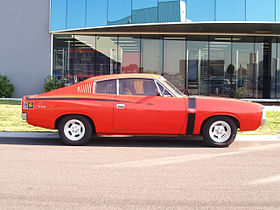Valiant Charger
| Chrysler Valiant Charger | |
|---|---|

Chrysler VH Valiant Charger R/T
|
|
| Overview | |
| Manufacturer | Chrysler Australia |
| Also called | Chrysler Charger (VK & CL series) |
| Production | 1971–1978 |
| Body and chassis | |
| Class | Muscle car |
| Body style | 2-door coupe |
| Layout | FR layout |
| Platform | A-body |
| Related |
Chrysler Valiant Dodge Dart Plymouth Valiant |
The Chrysler Valiant Charger is a muscle car introduced by Chrysler Australia in 1971. It was a short wheelbase two door coupe based on the concurrent Australian Chrysler Valiant sedan. Introduced within the VH Valiant series, it continued as a variant through the subsequent VJ, VK and CL series, until production ceased in 1978. It was marketed and badged as the Valiant Charger in the VH and VJ series and as the Chrysler Charger in the later VK and CL series.
The Charger was extraordinarily popular in Australia during the VH series. The VH Valiant Charger achieved critical acclaim, winning the 1971 Australian Wheels Car of the Year Award. It was also popular in New Zealand where they were assembled from imported kits.
The "muscle" image of the Charger faded through the VJ range of cars and was neutered altogether by 1975 release of the VK series.
During the seven years of production, the Charger carried many variations of essentially two basic powerplants, based on the Chrysler Hemi-6 Engine and versions of the Chrysler LA engine V8.
The Chrysler VH Valiant Charger range, introduced in 1971, consisted of Charger, Charger XL, Charger 770 and Charger R/T (Road/Track) models.
The R/T version carried on Chrysler's performance image from the VG series Valiant Pacer, and soon became the platform for Chrysler's participation in production car racing in Australia. The range of cars was broad-based to appeal to all manner of people:
The Charger R/T option E37 featured a tuned "Six Pack" version of the engine characterised by triple sidedraught Weber carburettors, formed the basis of Chrysler's touring car racer for 1971.This engine could also be ordered as an option on all models
The Charger R/T E49 engine produced remarkable torque on a seven bearing configuration which enabled considerable power development previously unobtained from 6-cylinder engines and not surpassed until the Porsche Turbo 911 (300) release of 1975
The Charger 770 SE (Special Edition) featured the E55 option; which was the 340ci 4bbl V8 engine, many motoring journalists correctly reported at the time as being imported by Chrysler for an aborted racing touring car homologation exercise. Chrysler Racing Manager John Ellis stated at the time that a ute fitted the 340ci V8 (and the same wheelbase as the R/T Charger) was track tested at the Mallala circuit in South Australia by racing driver Leo Geoghegan (and on local roads by Leo and his brother Ian), but was found to be 2–3 seconds slower around Mallala than the E49 (the heavier V8 at the front caused severe understeer and required earlier braking than the Hemi six). Despite the slower lap times at Mallala, it was expected that the extra power of the 340ci V8 would have worked better on the long straights and uphill runs at Bathurst where there were few heavy braking or tight corners. John Ellis then incorrectly stated that the 340ci engines were not imported for Bathurst and that an R/T 340 Charger was not being considered.
...
Wikipedia
